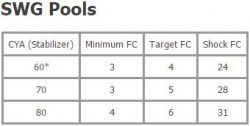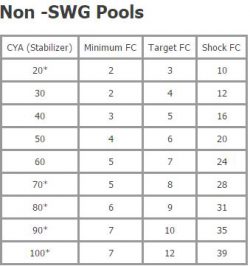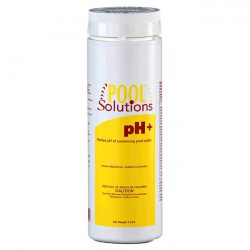Keeping your pool water properly balanced is one of the most important tasks a pool owner has, besides throwing cool, summer parties, of course. Most pool owners have a love-hate relationship with pool chemistry. They love it when their water levels are perfect and hate it when they are spending a ton of money to get it balanced again. Balancing your pool water should not be a daunting task. In fact, it could be as easy as A-B-C.
We get tons of calls and emails from customers asking us how to balance their pool water. There’s not one step by step guide that will work for every pool because every pool is very unique. However, if you can understand the relationship between the chemicals in your pool, then it becomes easier to manage your levels.
Balancing your pool water requires an understanding of the relationship between different chemical measurements in your pool. Your pool water’s chemistry is constantly in flux and therefore, chemical levels aren’t the same in January as it is in October. This makes understanding how one chemical affects the other crucial to balancing your pool.
The Basics
The word ‘balanced’, when discussing pool chemistry, comes from the idea that as water dissolves, it holds minerals until it becomes too saturated to hold anymore. Balance is the level at which water is neither over-saturated nor undersaturated.
In order to understand the relationship between each chemical level, you first need to know what you are measuring.
Free Chlorine (FC)
In order to have a balanced swimming pool, you have to maintain the correct levels of free chlorine (FC). Free chlorine is the available amount of chlorine that has disinfecting power. Free chlorine is consumed by two things, namely sunlight and organic materials in your pool. The amount of FC you need to maintain in your swimming pool depends on your cyanuric acid levels.
Check out TroubleFreePool.com’s chlorine/cyanuric chart for guidelines on the appropriate FC levels to maintain based on your cyanuric acid levels.


 When your FC is too low, algae are prominent to form. If your FC reaches 0, or you already have an algae bloom, we recommend you do not swim in the water until levels are balanced.
When your FC is too low, algae are prominent to form. If your FC reaches 0, or you already have an algae bloom, we recommend you do not swim in the water until levels are balanced.
Ways to raise FC: household bleach, liquid chlorine, and a salt-chlorine generator.
Acidity (pH)
Your pH level indicates how acidic your pool water is. The pH is a scientific scale from 0-14, with 7 being dead neutral. The ideal pH level is a 7.7 or 7.8. Anything between 7.5 and 7.8 is good, although, anything between 7.2 and 8.0 is acceptable for swimming. Everything that enters your pool, including rainwater, has a pH. So, it’s always good to check your pH levels once a week, to be on the safe side.
 Once your levels fall below 7.2, swimmers tend to experience stinging and burning eyes. Levels below 6.8 can cause severe damage to metal parts in your pool equipment if it is left untreated. It does not take long for a pool with low pH levels to weaken vinyl and heat exchangers.
Once your levels fall below 7.2, swimmers tend to experience stinging and burning eyes. Levels below 6.8 can cause severe damage to metal parts in your pool equipment if it is left untreated. It does not take long for a pool with low pH levels to weaken vinyl and heat exchangers.
Typically, to adjust the pH in your pool, you add pH increasers (bases) or a pH decreaser (acids).
Total Alkalinity (TA)
Alkalinity is closely related to pH. It measures all of the carbonates, bicarbonates, hydroxides, and other alkaline substances that are found in your pool. Total alkalinity is the water’s ability to withstand changes in your pH levels. The pool experts may refer to this as the “buffering capacity.” In a sense, the alkalinity in your pool keeps  your pH levels from fluctuating all over the place.
your pH levels from fluctuating all over the place.
Gunite and concrete pools should keep alkalinity levels between 80-120 ppm.
Painted, vinyl, and fiberglass pools should be maintained between 125-170 ppm.
Low alkalinity can be raised by adding a base, typically sodium bicarbonate(baking soda), while high alkalinity is typically lowered by adding an acid.
Calcium Hardness (CH)
When talking about calcium hardness, you are trying to determine how ‘hard’ or ‘soft’ your water is. ‘Hard’ water has high levels of calcium and magnesium. If these levels are too high, your water becomes too saturated. As a result, these extra deposits looks for other areas to deposit themselves on. Can you guess where they end up? On all types of surfaces in your pool. This includes your pool walls, ladders, lights, and stairs. In fact, you may even see little crystalline clumps all over your pool. Pool experts refer to this as scaling.
Once your CH levels are too low, your pool water is considered undersaturated. If your water becomes undersaturated it starts to look for other sources of calcium like your pool plaster. If it becomes too aggressive, it has the ability to corrode the inside of your pool surfaces.
starts to look for other sources of calcium like your pool plaster. If it becomes too aggressive, it has the ability to corrode the inside of your pool surfaces.
A healthy range to keep your CH is at 220-350 ppm if you do not have a salt chlorine generator. If you do own one, your levels should be maintained between 350-450 ppm.
You can increase your CH with calcium chloride or calcium chloride dihydrate. You can decrease your CH by replacing some of the water in your pool to offset the balance.
Cyanuric Acid (CYA)
Cyanuric acid, sometimes referred to as stabilizer, protects your FC from sunlight and reserves some of the FC for future use. In a sense, it acts as an umbrella for your FC.  The higher your CYA levels are, the more FC you will need to get the same effect. It is essential to monitor your CYA in order to determine what your FC levels should be.
The higher your CYA levels are, the more FC you will need to get the same effect. It is essential to monitor your CYA in order to determine what your FC levels should be.
Without a salt water generator, your CYA levels should stay within 30-50.
With a salt water generator, CYA levels are typically kept between 70-80. You can increase your CYA levels by adding more cyanuric acid.
In most cases, the best way to decrease your CYA levels is simply to replace your water.
Once you have a basic understanding on how each level chemical affects the other, balancing your pool becomes a little less confusing and a lot more manageable. With a lot of things in life, the more you do something, the more comfortable you become with the process.
If you are unsure about your pool’s levels or came up with inaccurate readings, have your water retested. Many local pool stores tests pool water for free. And if you are still unsure, have it tested again. There is no harm in testing your water frequently.
**Acknowledgment: The original Chlorine/CYA “Best Guess” chart was developed by Ben Powell. Richard Falk (chem geek) has refined and expanded on that original to produce theChlorine/CYA Chart by Chem Geek based on experiences with members on Troublefreepool.com and the old Pool Forum and conformation to chemical theory**













Leave a Reply